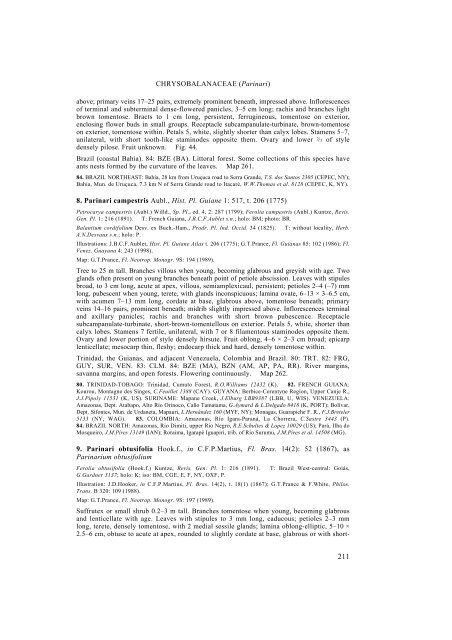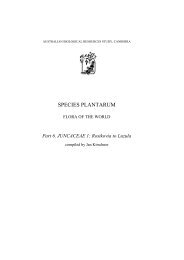Vol. 1 part 2 - Species Plantarum Programme
Vol. 1 part 2 - Species Plantarum Programme
Vol. 1 part 2 - Species Plantarum Programme
You also want an ePaper? Increase the reach of your titles
YUMPU automatically turns print PDFs into web optimized ePapers that Google loves.
CHRYSOBALANACEAE (Parinari)<br />
above; primary veins 17–25 pairs, extremely prominent beneath, impressed above. Inflorescences<br />
of terminal and subterminal dense-flowered panicles, 3–5 cm long; rachis and branches light<br />
brown tomentose. Bracts to 1 cm long, persistent, ferrugineous, tomentose on exterior,<br />
enclosing flower buds in small groups. Receptacle subcampanulate-turbinate, brown-tomentose<br />
on exterior, tomentose within. Petals 5, white, slightly shorter than calyx lobes. Stamens 5–7,<br />
unilateral, with short tooth-like staminodes opposite them. Ovary and lower 2 /3 of style<br />
densely pilose. Fruit unknown. Fig. 44.<br />
Brazil (coastal Bahia). 84: BZE (BA). Littoral forest. Some collections of this species have<br />
ants nests formed by the curvature of the leaves. Map 261.<br />
84. BRAZIL NORTHEAST: Bahia, 28 km from Uruçuca road to Serra Grande, T.S. dos Santos 2305 (CEPEC, NY);<br />
Bahia, Mun. de Uruçuca, 7.3 km N of Serra Grande road to Itacaré, W.W.Thomas et al. 8128 (CEPEC, K, NY).<br />
8. Parinari campestris Aubl., Hist. Pl. Guiane 1: 517, t. 206 (1775)<br />
Petrocarya campestris (Aubl.) Willd., Sp. Pl., ed. 4, 2: 287 (1799); Ferolia campestris (Aubl.) Kuntze, Revis.<br />
Gen. Pl. 1: 216 (1891). T: French Guiana, J.B.C.F.Aublet s.n.; holo: BM; photo: BR.<br />
Balantium cordifolium Desv. ex Buch.-Ham., Prodr. Pl. Ind. Occid. 34 (1825). T: without locality, Herb.<br />
A.N.Desvaux s.n.; holo: P.<br />
Illustrations: J.B.C.F.Aublet, Hist. Pl. Guiane Atlas t. 206 (1775); G.T.Prance, Fl. Guianas 85: 102 (1986); Fl.<br />
Venez. Guayana 4: 243 (1998).<br />
Map: G.T.Prance, Fl. Neotrop. Monogr. 9S: 194 (1989).<br />
Tree to 25 m tall. Branches villous when young, becoming glabrous and greyish with age. Two<br />
glands often present on young branches beneath point of petiole abscission. Leaves with stipules<br />
broad, to 3 cm long, acute at apex, villous, semiamplexicaul, persistent; petioles 2–4 (–7) mm<br />
long, pubescent when young, terete, with glands inconspicuous; lamina ovate, 6–13 × 3–6.5 cm,<br />
with acumen 7–13 mm long, cordate at base, glabrous above, tomentose beneath; primary<br />
veins 14–16 pairs, prominent beneath; midrib slightly impressed above. Inflorescences terminal<br />
and axillary panicles; rachis and branches with short brown pubescence. Receptacle<br />
subcampanulate-turbinate, short-brown-tomentellous on exterior. Petals 5, white, shorter than<br />
calyx lobes. Stamens 7 fertile, unilateral, with 7 or 8 filamentous staminodes opposite them.<br />
Ovary and lower portion of style densely hirsute. Fruit oblong, 4–6 × 2–3 cm broad; epicarp<br />
lenticellate; mesocarp thin, fleshy; endocarp thick and hard, densely tomentose within.<br />
Trinidad, the Guianas, and adjacent Venezuela, Colombia and Brazil. 80: TRT. 82: FRG,<br />
GUY, SUR, VEN. 83: CLM. 84: BZE (MA), BZN (AM, AP, PA, RR). River margins,<br />
savanna margins, and open forests. Flowering continuously. Map 262.<br />
80. TRINIDAD-TOBAGO: Trinidad, Cumuto Forest, R.O.Williams 12432 (K). 82. FRENCH GUIANA:<br />
Kourou, Montagne des Singes, C.Feuillet 1388 (CAY). GUYANA: Berbice-Corentyne Region, Upper Canje R.,<br />
J.J.Pipoly 11531 (K, US). SURINAME: Mapane Creek, J.Elburg LBB9387 (LBB, U, WIS). VENEZUELA:<br />
Amazonas, Dept. Atabapo, Alto Río Orinoco, Caño Tamatama, G.Aymard & L.Delgado 8418 (K, PORT); Bolívar,<br />
Dept. Sifontes, Mun. de Urdaneta, Mapauri, L.Hernández 160 (MYF, NY); Monagas, Guarapiche F. R., F.J.Breteler<br />
5133 (NY, WAG). 83. COLOMBIA: Amazonas, Río Igara-Paraná, La Chorrera, C.Sastre 3443 (P).<br />
84. BRAZIL NORTH: Amazonas, Rio Dimiti, upper Rio Negro, R.E.Schultes & Lopez 10029 (US); Pará, Ilha do<br />
Mosqueiro, J.M.Pires 13149 (IAN); Roraima, Igarapé Iguapiri, trib. of Rio Surumu, J.M.Pires et al. 14508 (MG).<br />
9. Parinari obtusifolia Hook.f., in C.F.P.Martius, Fl. Bras. 14(2): 52 (1867), as<br />
Parinarium obtusifolium<br />
Ferolia obtusifolia (Hook.f.) Kuntze, Revis. Gen. Pl. 1: 216 (1891). T: Brazil West-central: Goiás,<br />
G.Gardner 3137; holo: K; iso: BM, CGE, E, F, NY, OXF, P.<br />
Illustration: J.D.Hooker, in C.F.P.Martius, Fl. Bras. 14(2), t. 18(1) (1867); G.T.Prance & F.White, Philos.<br />
Trans. B 320: 109 (1988).<br />
Map: G.T.Prance, Fl. Neotrop. Monogr. 9S: 197 (1989).<br />
Suffrutex or small shrub 0.2–3 m tall. Branches tomentose when young, becoming glabrous<br />
and lenticellate with age. Leaves with stipules to 3 mm long, caducous; petioles 2–3 mm<br />
long, terete, densely tomentose, with 2 medial sessile glands; lamina oblong-elliptic, 5–10 ×<br />
2.5–6 cm, obtuse to acute at apex, rounded to slightly cordate at base, glabrous or with short-<br />
211












